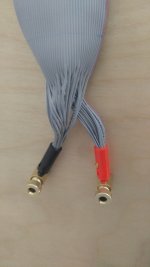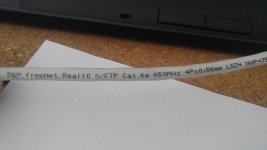Looks like an ordinari computer ribbon cable, hope you didn't pay the tip of a jet, have seen examples of some ridiculous prices on speaker cables, I aim for short length and plenty of copper.
It's ribbon data cable and it costed around 2€/m 5m/lot 1.27mm Spacing Pitch 6/8/10/12/14/16/20/26/34/40 pin Grey Flat Ribbon Data Cable Wire Connector AWG28 300V|5m wire|connector flatpitch connector - AliExpress, it's easy to split and strip with my fingers and nails no tools required.
4x 0.56 mm = 0.99 mm²
20x AWG28 = 1.6 mm²
So yes, that's actually an upgrade. Still no 2.5 or even 4 mm² though (I think the latter may be more common here in 4 ohm land).
20x AWG28 = 1.6 mm²
So yes, that's actually an upgrade. Still no 2.5 or even 4 mm² though (I think the latter may be more common here in 4 ohm land).
This sort of extreme high capacitance cable will make some amplifiers unstable and modify the frequency response of others
I think it wasn't 4x0.56 but 2x2x0.56mm = 2x0,25 mm² each wire. Very few.4x 0.56 mm = 0.99 mm²
20x AWG28 = 1.6 mm²
20 x AWG28 = 2 x 0.81 mm² each wire (yes, still not too much. Maybe ok for 8 R high-sensivity speakers).
Last edited:
About capacitance of the cable I never thought about it until now and, according to my meter, is 4 nanofarads is it extremely high for my amplifier to handle?
About the cat6a cable it's 4 pairs of 0,56 mm, picture attached, I've been using it because it as the same twist rate in all the pairs (I've dismantled same cat cables that, if I remember, had a > 5% difference in length between pairs) and it should be able to handle my 2x40W amp.
The new one should handle about 2.5X the power.
The new one should handle about 2.5X the power.
Attachments
I think the issue is more about Inductance and resistance , your amp sees much more capacitance in your passive filter.
I think the issue is more about Inductance and resistance , your amp sees much more capacitance in your passive filter.
The cable capacitance is directly across the output of the amp, the capacitance of the crossove is not.
Mike
Okay, so pretty short, I think your cables are no issue, you use low power, it's all about the interaction between amp/cable/speaker, if you're happy with the sound, and there is no instability/oscillation all is good.
I think the issue is more about Inductance and resistance , your amp sees much more capacitance in your passive filter.
The cable capacitance is directly across the output of the amp, the capacitance of the crossover is not.
Mike
Hi amplitude, my amps can only see a passive filter in their dreams!!
My speakers are fullrange no filters with the exception of my bi-amped speakers and even those amps have to look back... the filters are in the amps input.
My speakers are fullrange no filters with the exception of my bi-amped speakers and even those amps have to look back... the filters are in the amps input.
The relationship between inductance and capacitance of a cable is:
LC = 1034* EDC.
L in nH per foot, C in pf per foot, EDC being the equivalent relative dielectric of the insulation. For typical cables, EDC will range from 5 to about 10 depending on how close the legs really are. For coax EDC reverts to DC, the actual coefficient of the insulation.
CAT5e (and up) cable is usually made with four independent twist pitches to prevent magnetic coupling between pairs. However, the change in actual length is zero for all practical purposes.
The concern with instability is only a worry if the amplifier is very "hot", very high bandwidth.. When the speaker unloads at very high frequencies, if the amplifier still has more than unity gain internally, then the amp will only see the capacitance of the cable.
If you are very worried, you can put a Zobel at the speaker, its purpose in life is to maintain a low impedance at the far end of the cable.
The Zobel resistance should be that of the cable's characteristic impedance. Calculate that as 150/number of pairs. 1 pair, 150 ohms, 10 pairs 15 ohms..
John
LC = 1034* EDC.
L in nH per foot, C in pf per foot, EDC being the equivalent relative dielectric of the insulation. For typical cables, EDC will range from 5 to about 10 depending on how close the legs really are. For coax EDC reverts to DC, the actual coefficient of the insulation.
CAT5e (and up) cable is usually made with four independent twist pitches to prevent magnetic coupling between pairs. However, the change in actual length is zero for all practical purposes.
The concern with instability is only a worry if the amplifier is very "hot", very high bandwidth.. When the speaker unloads at very high frequencies, if the amplifier still has more than unity gain internally, then the amp will only see the capacitance of the cable.
If you are very worried, you can put a Zobel at the speaker, its purpose in life is to maintain a low impedance at the far end of the cable.
The Zobel resistance should be that of the cable's characteristic impedance. Calculate that as 150/number of pairs. 1 pair, 150 ohms, 10 pairs 15 ohms..
John
In the case of the cat6a cables I'm using they are S/FTP and the magnetic coupling between pairs is prevented by the individual foil around each pair, so they can have the same twist rate.
Cat6 pairs are specced at 46pF/m x 4pairs = 200pF/m or 500pf/2.5m which should be fine for pretty much any amp.About capacitance of the cable I never thought about it until now and, according to my meter, is 4 nanofarads is it extremely high for my amplifier to handle?
The figure you give for the ribbon cable sounds high at 4000pf/2.5m, you might need to check your measurement, also measure your Cat6 cables and compare.
- Home
- Design & Build
- Parts
- Finally replacing my budget Cat6 speaker cables...

